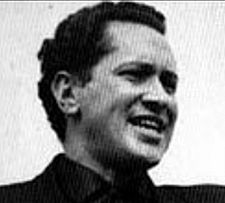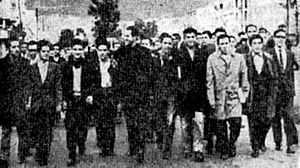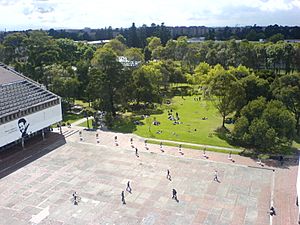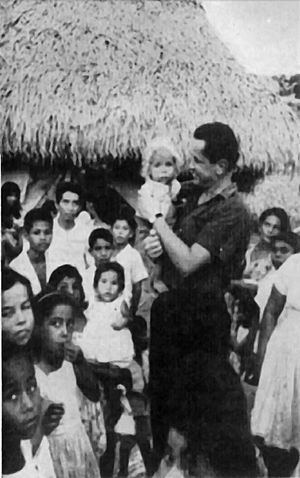Camilo Torres Restrepo facts for kids
Quick facts for kids Camilo Torres Restrepo |
|
 Camilo Torres |
|
| Born | 3 February 1929 in Bogotá, Colombia |
|---|---|
| Died | 15 February 1966 (aged 37) in San Vicente de Chucurí, Santander, Colombia |
| Nationality | Colombian |
| Church | Catholic Church |
| Ordained | 1954 (priest) |
| Parents | Calixto Torres Umaña Isabel Restrepo Gaviria |
Camilo Torres Restrepo (born February 3, 1929 – died February 15, 1966) was a Colombian Roman Catholic priest. He was also a sociologist, which means he studied how societies work. Camilo Torres believed strongly in helping poor people and fighting for fairness. He became a supporter of liberation theology, which is a way of thinking that combines Christian faith with social justice.
He was also a member of a group called the National Liberation Army (ELN), which was a guerrilla organization. Camilo Torres tried to bring together his Catholic beliefs with ideas about social change and revolution. His work for social justice and his willingness to work with people who had different political ideas sometimes caused problems for him.
As a professor at the National University of Colombia, he helped start the Sociology Department in 1960. He became very popular with students and many people followed his ideas. However, the Colombian government and even some parts of the church did not like his strong political views. Because of this pressure, Camilo Torres left his job and joined the ELN guerrillas.
He served as a member of the ELN, offering spiritual guidance and inspiration from a Christian point of view. He died in his first battle when the ELN fought against a Colombian military group. After his death, Camilo Torres became a hero for the ELN. He is famous for saying, "If Jesus were alive today, He would be a guerrillero."
Contents
Biography
Early Life and Education
Camilo Torres Restrepo was born in Bogotá, Colombia, on February 3, 1929. His family was well-off. When he was two years old, his parents took him to Europe. He came back to Colombia in 1934. A few years later, in 1937, his parents separated. Camilo and his brother Fernando stayed with their mother.
Camilo was a bright student but was expelled from one school for criticizing his teachers. He finished high school in 1946. After high school, he started studying law at the Universidad Nacional de Colombia. During this time, he wrote articles for a newspaper.
He later decided to become a priest. This idea came from meeting two French priests who had strong social ideas. Even though his parents were not sure about his decision, Camilo entered the seminary in Bogotá. He spent seven years there and became very interested in social problems and helping people.
Becoming a Priest and Professor
After becoming a priest in 1954, Camilo Torres focused on poverty and social injustice. He started social activities in poor neighborhoods around the seminary, helping families who had been forced to leave their homes in the countryside.
In 1955, he went to Belgium to study more at the Catholic University of Louvain. He studied sociology there and learned about Christian democracy and workers' movements. In 1958, he earned his degree in sociology. His research focused on the social and economic situation of Bogotá.
When he returned to Colombia in 1959, he felt he needed to actively support poor and working-class people. He became a chaplain at the National University of Colombia. In 1960, he helped create the first Sociology Faculty in Latin America at the university. He was a popular professor and worked closely with students. He also helped start community action programs in working-class areas of Bogotá.
Camilo Torres also worked with the Colombian Institute of Agrarian Reform (INCORA). He wanted to help peasants organize and get land reform. He believed that the government's efforts were not enough to help the poor farmers.
Entering Politics
Camilo Torres became more involved in politics. He saw that the traditional political parties in Colombia were not helping ordinary people enough. He believed that a new movement was needed to bring together different groups like unions, students, and workers.
He argued that the Catholic Church should help fight social inequality. He believed that to truly show Christian love, the power structures in society needed to change. He felt that these structures were causing poverty and unfairness.
He pointed out that Marxists were often leading the fight for these changes. He concluded that Christians should work with Marxists to achieve a better society. He believed that Christians should not be afraid to act and make a difference.
In 1964, Camilo Torres tried to help prevent a military conflict in a rural area called Marquetalia. He was part of a group trying to find a peaceful solution. However, the military action went ahead, and this led to the formation of the Revolutionary Armed Forces of Colombia (FARC).
Later that year, he started to connect with groups that believed in armed revolution. He felt a strong sense of support for them. The National Liberation Army (ELN) was formed in 1964. Camilo felt it was very important to connect with this group.
The United Front and Joining the Guerrilla
In 1964, Camilo Torres helped create the "United Front of the Colombian People." This movement was against the traditional political parties. He wanted to unite all the groups that were against the government.
However, his activities became very political. In June 1965, his church superior, Cardinal Concha, told him he could no longer be an active priest because his political work went against church rules at the time. Camilo Torres asked to be allowed to focus on politics. He gave his last mass on June 27, 1965.
The United Front movement aimed to help both rural and urban areas and to change the political system. Despite its growing popularity, Camilo Torres decided to join the ELN guerrilla group. He felt that armed struggle was necessary to bring about real change for the people. On January 7, 1966, he officially announced he was joining the ELN.
As a Catholic Guerrilla
In the ELN, Camilo Torres used the code name Argemiro. He was not a trained fighter, so he mainly provided spiritual and ideological support. He explained his decision to join the guerrillas in a message to Christians. He said that the powerful minorities would not give up their privileges easily. He believed that "the Revolution is not only permitted but obligatory for Christians who see in it the only effective and ample way of realising love for all."
He wrote: "I have left the privileges and duties of the clergy, but I have not ceased to be a priest. I believe that I have given myself up to the Revolution out of love of neighbour. I have stopped saying mass to realise this love of neighbour, in the temporal, economic and social fields. When my neighbour has nothing against me, when I have achieved the Revolution, I will offer mass again, if God allows me to do so."
Camilo Torres was not used to the hard training of the guerrillas. He was given a pistol, but his main role was to offer spiritual guidance and help with cooking. He died in his first combat experience.
Death

Camilo Torres died on February 15, 1966, in a place called Patio Cemento. He was killed during a fight with troops from the Colombian National Army. The army hid his body, and its exact location was not revealed to the public for a long time. A symbolic funeral and burial were held for him in Bogotá.
Years later, the general who led the troops that day, Álvaro Valencia Tovar, wrote a book about Camilo Torres's death. He said that Torres's body was buried in a specific place. In 2016, the President of Colombia, Juan Manuel Santos, asked the army to search for his remains. This was a gesture to help start peace talks with the ELN guerrilla group.
Tributes at Universities
- The main theater at the University of Antioquia is named "Comandante Camilo Torres Restrepo" Popular Theater.
- One of the main buildings at the Industrial University of Santander is called "Camilo Torres Building." It has a large mural of his face and a quote he wrote.
- At the University of Valle in Cali, there is a bust honoring Camilo Torres.
Images for kids
See also
 In Spanish: Camilo Torres Restrepo para niños
In Spanish: Camilo Torres Restrepo para niños
- Christian communism








